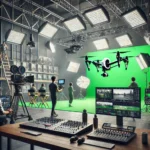Film photography is experiencing a resurgence in popularity, as more people are drawn to its nostalgic charm, authentic feel, and the creative challenges it offers. Whether you’re a hobbyist or aspiring professional, this guide will walk you through the essential steps to get started in film photography.
Why Choose Film Photography?
Before diving into the details, it’s important to understand why film photography remains appealing:
- Timeless Aesthetic: Film creates a unique, organic look that digital cameras often struggle to replicate.
- Discipline: Film photography teaches you to be more deliberate, thinking carefully about each shot.
- Physical Media: There’s something magical about holding a physical print that you developed yourself.
Selecting Your First Film Camera
Choosing the right camera is a critical first step. Here’s a breakdown of the main types:
- 35mm SLR (Single-Lens Reflex): The most common choice for beginners, offering a good balance of quality and price. Models like the Canon AE-1 and Nikon FM2 are widely recommended.
- Medium Format Cameras: These offer higher resolution and more detail but come with a steeper learning curve and higher costs. Popular models include the Mamiya 645 and Hasselblad 500CM.
- Point-and-Shoot Cameras: Perfect for beginners who want simplicity. The Olympus Stylus Epic and Contax T2 are reliable choices.
Understanding Film Types
Film photography offers a wide range of film types, each giving a different aesthetic:
- Color Negative Film: Standard for everyday shooting, producing warm, vibrant colors. Examples include Kodak Portra 400 and Fuji Pro 400H.
- Black and White Film: Offers high contrast and dramatic imagery, popular among artistic photographers. Try Ilford HP5 or Kodak Tri-X.
- Slide Film (Reversal Film): Provides vivid, true-to-life colors but requires more precise exposure settings. Fujifilm Velvia 50 is a great choice for landscapes.
Mastering Exposure
Understanding exposure is crucial in film photography, as you don’t get the immediate feedback that digital cameras provide:
- Aperture (f-stop): Controls the depth of field and the amount of light entering the camera. A lower f-stop (e.g., f/2.8) lets in more light and blurs the background, while a higher f-stop (e.g., f/16) sharpens everything.
- Shutter Speed: Determines how long the shutter stays open, affecting motion in your image. A faster speed (e.g., 1/500) freezes action, while a slower speed (e.g., 1/30) introduces motion blur.
- ISO: A film’s sensitivity to light. Lower ISO films (e.g., ISO 100) are best for bright daylight, while higher ISO films (e.g., ISO 800) are better for low-light conditions.
Learning to Develop Film
Developing your own film can be a rewarding experience. Here’s a basic overview:
- Black and White Development: Easier and less expensive than color film. You’ll need developer, stop bath, and fixer chemicals, along with basic equipment like reels, tanks, and thermometers.
- Color Development: More complex but achievable at home with the right chemicals and equipment. The C-41 process is standard for color negative films.
Where to Get Your Film Developed
If you’re not ready to develop film at home, there are plenty of labs that specialize in film development. Here are some options:
- Local Photo Labs: Many cities still have professional photo labs that can develop film for you.
- Mail-In Services: Companies like The Darkroom and Richard Photo Lab offer reliable mail-in development services.
Essential Tips for Shooting on Film
Here are a few additional tips for getting the best results from your film photography journey:
- Meter Your Shots: Use a light meter (or your camera’s built-in meter) to ensure proper exposure.
- Experiment: Don’t be afraid to try different films and cameras to find your personal style.
- Shoot in Good Light: Film often struggles in very low-light situations, so try to shoot in natural, well-lit environments.
Film photography is more than just a medium—it’s a way to slow down and truly appreciate the art of taking a picture. By carefully selecting your gear, understanding the basics of exposure, and learning how to develop your film, you’ll be well on your way to mastering this timeless craft.


